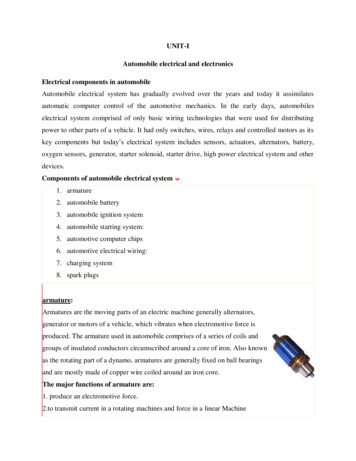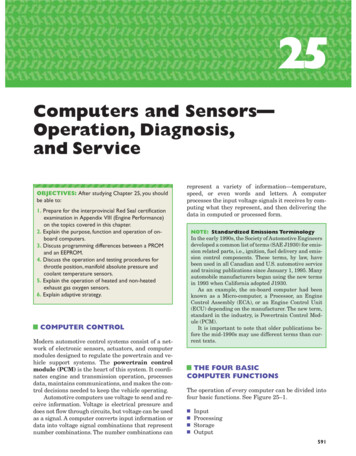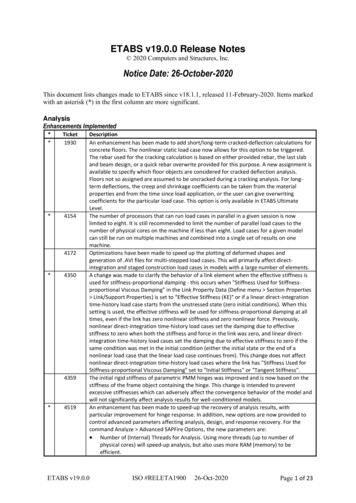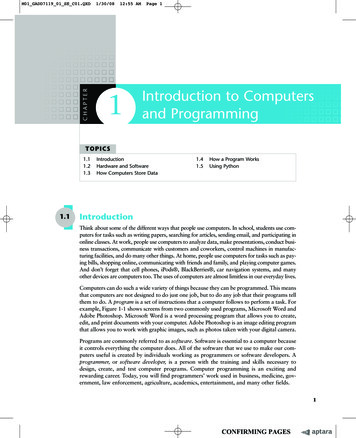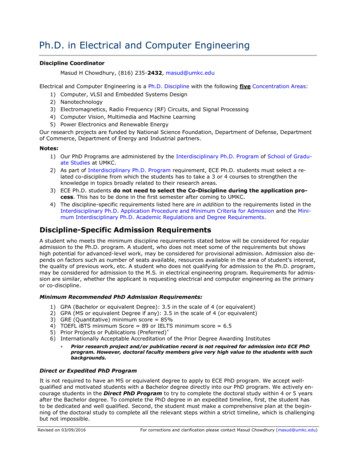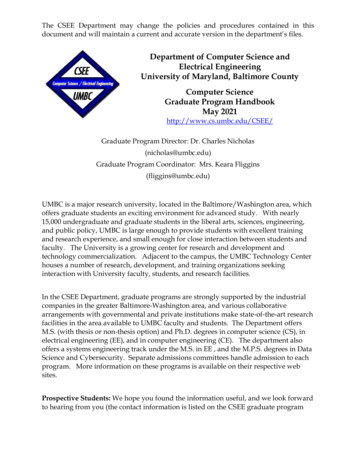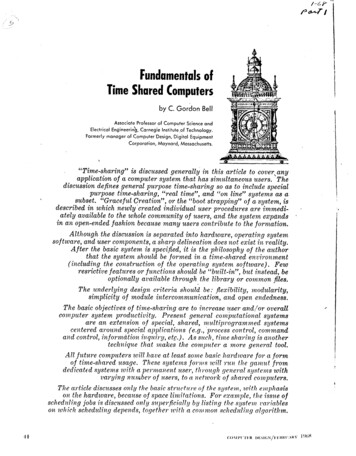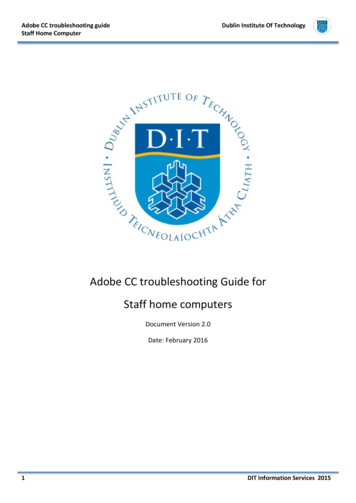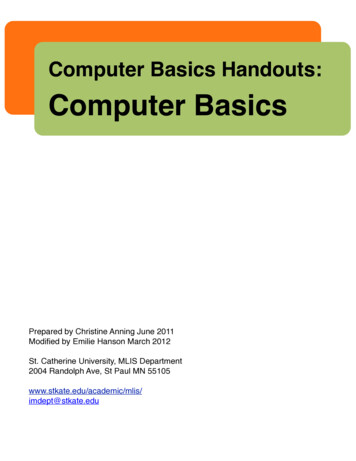
Transcription
Computers and Electrical Engineering 77 (2019) 314–324Contents lists available at ScienceDirectComputers and Electrical Engineeringjournal homepage: www.elsevier.com/locate/compelecengCyber-physical application monitoring across multiplecloudsR,RRAyman Noor a,b, , Karan Mitra c, Ellis Solaiman a, Arthur Souza d,Devki Nandan Jha a, Umit Demirbaga a,e, Prem Prakash Jayaraman f, Nelio Cacho d,Rajiv Ranjan aaNewcastle University, Newcastle upon Tyne, UKTaibah University, Madinah, Saudi ArabiacLuleå University of Technology, Skellefteå, SwedendFederal University of Rio Grande do Norte, Natal, BrazileBartin University, Bartin, TurkeyfSwinburne University of Technology, Melbourne, Australiaba r t i c l ei n f oArticle history:Received 30 November 2018Revised 6 June 2019Accepted 13 June 2019Keywords:Cyber-physical systemMonitoringLinear road benchmarkQoSVirtualizationCloud computinga b s t r a c tCyber-physical systems (CPS) integrate cyber-infrastructure comprising computers and networks with physical processes. The cyber components monitor, control, and coordinate thephysical processes typically via actuators. As CPS are characterized by reliability, availability, and performance, they are expected to have a tremendous impact not only on industrial systems but also in our daily lives. We have started to witness the emergence ofcloud-based CPS. However, cloud systems are prone to stochastic conditions that may leadto quality of service degradation. In this paper, we propose M2CPA - a novel frameworkfor multi-virtualization, and multi-cloud monitoring in cloud-based cyber-physical systems.M2CPA monitors the performance of application components running inside multiple virtualization platforms deployed on multiple clouds. M2CPA is validated through extensiveexperimental analysis using a real testbed comprising multiple public clouds and multivirtualization technologies. 2019 Elsevier Ltd. All rights reserved.1. IntroductionCPS is an interdisciplinary approach for combining communication devices, computation, and actuation for performingtime-constrained actions in a predictive and adaptive manner [2,3]. This is done using a feedback loop within the physicalsystem, which enables the embedded and network systems to monitor and control the physical processes. In this waythe design of a previous model can be modified using feedback from the physical system. This also makes the systemmore robust, reliable and free from any past errors. According to the National Institute of Information and CommunicationRThis journal paper is a significantly extended version of conference paper published by IEEE Cloud 2019 conference [1].This paper is for CAEE special section SI-csc. Reviews processed and recommended for publication to the Editor-in-Chief by Guest Editor Dr. XiaokangZhou. Corresponding author.E-mail address: aymannoor84@gmail.com (A. .06.0070045-7906/ 2019 Elsevier Ltd. All rights reserved.
A. Noor, K. Mitra and E. Solaiman et al. / Computers and Electrical Engineering 77 (2019) 314–324315Fig. 1. Cyber-physical system and an example of stream data management for highway monitoring system.Technology (NIST) [4], cyber-physical cloud computing is “a system environment that can rapidly build, modify and provisioncyber-physical systems composed of a set of cloud computing based sensors, processing, control, and data services”.CPS consists of three main elements: cyber, physical, and network components. Each of these components consists of afew other components. For example, the cyber component consists of two components: cloud and IoT devices where the IoTdevices work as a bridge between physical and cyber components. The network component is used for interlinking the cyberand physical components and transferring and controlling data as shown in Fig. 1. In order to develop a robust architecturefor a CPS solution, data needs to be collected from various physical sources (for example traffic, education, and healthcaresystems [5]) using IoT devices (e.g. sensor, mobile, and a camera). Every day larger applications with more devices are beingconnected with CPS, which means that a larger variety of physical conditions need to be considered, and this requires largervolumes of data to be extracted using IoT devices, and filtered and processed using cloud data centres (cloud). Therefore themain components of a CPS can be summarised as follows:1. Physical Component: This component does not have any computation or communication capability; it only includesbiochemical processes, mechanical processes, or humans. Physical components collect and provide data, which is required to be processed in real time for controlling various activities. Such data is usually highly concurrent and dynamic.2. Cyber Component: is used for collecting, processing, reporting and controlling all the physical components withinCPS. As it is challenging to manage the concurrent and dynamic data from the physical component of CPS, the cybercomponent is divided into two sub-systems. These are cloud data centers, and IoT devices [5].3. Network Component: is responsible for communication between the physical and cyber components or among thecyber components. The raw data is captured from components such as IoT devices and passed to the cloud. Also, clouddevices send control and feedback to the IoT devices using network components. Main factors that affect networkcommunications are bandwidth, topology, latency, and congestion [6,7].1.1. Research contextFig. 1 describes a conceptual implementation of highway traffic monitoring services using a cyber-physical system. Thesensed data of highway traffic (for example the position of the cars) is sent as a stream of events that is physically separatedand used for problems such as traffic monitoring and management. This requires the processing of huge volumes of datawith high efficiency using the capabilities of multi-cloud environments [3,8,9].To effectively explore data processing in a multi-cloud environment, three services for highway traffic are considered.These are: (i) Toll Collection Notification, (ii) Accident Alerts, and (iii) Car Count (a detailed discussion is given in Section 4).The system will manage its resources in terms of sensor data and other saved data available in the cloud and provide therequested information to the driver. For example, the highway traffic system will send an alert to drivers on their navigationsystems to inform them to take appropriate routes (push mode). Also the driver can request information about traffic routes,and then make informed decisions based on that information (pull mode).The performance of a cyber-physical application in cloud systems may vary considerably due to factors such as application type, interference effect (caused by other applications running in the same or different containers), resource failure andcongestion. Quality of Service (QoS) denotes the levels of service offered by the cloud provider in terms of service featuresdepending on the user’s/application’s requirements [10]. QoS is generally defined in terms of application specific featuressuch as availability, pricing, capacity, throughput, latency, and reliability or user dependent features such as certification,reputation, and user experience rating. QoS is essential for both the user who expects the cloud provider to deliver thepublished services, and the provider who needs to find a balance between the offered service and functional cost. Agreement between the user and the provider on the quality of service offered leads to a Service Level Agreement (SLA) [11].SLA creates transparency between user and cloud provider by defining a common ground, which is agreed by both user
316A. Noor, K. Mitra and E. Solaiman et al. / Computers and Electrical Engineering 77 (2019) 314–324and cloud provider. Appropriate penalties are normally associated with the SLA, which are applied in case of SLA violations. Therefore, it is imperative to monitor the QoS provided by the cloud provider to check whether the SLA is satisfiedor not. Monitoring is required for different purposes such as resource provisioning [12], scheduling [13–15], security [16],and re-encryption [17,18]. To detect any performance anomaly or to ensure that SLA requirements are achieved, continuousmonitoring is essential [19].In virtualized environments, an application may be distributed over multiple containers/VMs, each running some servicescommunicating over REST-based APIs [20]. Monitoring is required at both individual container/VM level or at applicationlevel to guarantee that the QoS requirements of the application are satisfied. There are some lightweight endpoints availablethat can easily be plugged in to perform the monitoring operations for a single environment application. However, forcomplex containerized applications, it is challenging to have a single monitoring end-point, because each container may behosted on different environments that do not support a common monitoring endpoint.1.2. Research contributionsCurrently, there are multiple monitoring frameworks e.g. Docker stat, CAdvisor, DataDog, Amazon CloudWatch, CLAMS[21], available to monitor the applications running in the cloud. However, most of the frameworks are either cloud providerspecific e.g. Microsoft Azure Fabric Controller, or virtualization architecture specific e.g. CAdvisor. These monitoring toolsare not able to satisfy the complex dependent requirements of CPS that can provide holistic monitoring across multi-cloudscenarios supporting different types of virtualization. Monitoring the performance of services in such a complex environmentis very challenging for the following reasons: The deployment environment for cyber-physical applications in multi-cloud environments is very complex as thereare numerous components running in heterogeneous environments (VM/container) and communicating frequentlywith each other using REST-based/REST-less APIs. In some cases, multiple components can also be executed inside acontainer/VM making any failure or anomaly detection very complicated. It is necessary to monitor the performancevariation of all the service components to detect any reason for failure. Considering the virtualization environment, deployment of cyber-physical applications in containers is very different from that in VM. Containers are defined in terms of namespace and cgroups that share the same host machinewhereas each VM is isolated with its own operating system. Also, the resource limitation in containers can be hard orsoft as compared to VM which is always strict (hard). A soft limit allows containers to extend beyond their allocatedresource limit creating higher chances of interference [22]. Monitoring the performance of cyber-physical applicationsin such cross VM-container scenarios is very important to ensure that services are executing in a desirable way. Modern applications can be distributed across multiple cloud environments including bare metal, public or privatecloud depending on several features such as cyber-physical application component requirements, deployment locations, security concerns, cost, etc. Different cloud providers have their own way of handling deployment and management of cyber-physical application components. Due to the heterogeneity of cloud providers, it is complex to haveholistic management of application components.Based on the aforementioned challenges, this paper addresses the following research questions: How to monitor the performance of distributed software components of cyber-physical applications running on heterogeneous virtualization platforms within the same or different cloud service providers? How to aggregate QoS measures of cyber-physical applications running in multiple cloud environments to give aholistic view of performance?To answer these questions, this paper makes following new contributions: It introduces a novel framework: Multi-virtualization, Multi-cloud Monitoring in Cyber-Physical Applications (M2CPA)that provides a holistic approach to monitor the performance of CPS applications composed into multiple applicationsdeployed/running in a multi-cloud and heterogeneous environment (e.g. using different virtualization technologies). It validates the proposed monitoring framework M2CPA, via a proof of concept implementation that monitors cyberphysical application performance running across different cloud service providers using different virtualization means.Experimental analysis verifies the efficacy of our proposed monitoring framework.The rest of this paper is organized as follows. Section 2 discusses recent related work. The M2CPA framework designis presented in Section 3. Section 4 presents the proof of concept implementation of M2CPA and Section 5 discusses theoutcomes of experimental evaluation. The paper concludes by giving some future work suggestions in Section 6.2. Related workThere are already industry monitoring tools whether in containers [Docker, CAdvisor, Datadog] or in cloud [CloudWatch,Microsoft Azure Fabric]; and academic monitoring tools whether in VMs [14,21] or even in containers [23,24].
A. Noor, K. Mitra and E. Solaiman et al. / Computers and Electrical Engineering 77 (2019) 314–324317Table 1Comparison of related work.Parameter(monitoring)Related workM2CPADockerCAdvisorDatadogVirtual Machine (VM)ContainerMultiple CloudCyber-Physical Systems CloudWatch CLAMS Microsoft Azure Fabric PyMon Docker1 provides an inbuilt monitoring tool, Docker stats, to examine the resource usage metrics of running containers.The various metrics provided by Docker stats are CPU and memory usage, and actual free memory for each container.However, it does not inspect the performance of individual applications running inside a container. Our proposed framework,M2CPA, improves on this significantly by monitoring the performance of each application running inside a container. Alongw
01.07.2019 · physical application performance running across different cloud service providers using different virtualization means. Experimental analysis verifies the efficacy of our proposed monitoring framework. The rest of this paper is organized as follows. Section 2 discusses recent related work. The M2CPA framework design is presented in Section 3.
